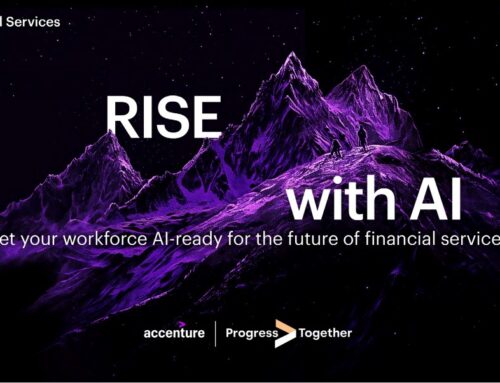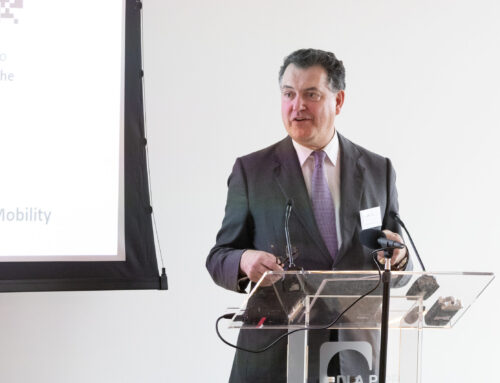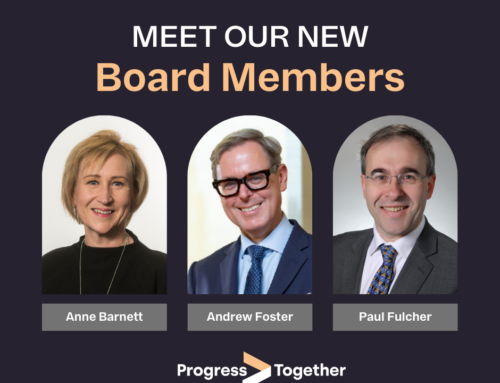Click here to Read Shaping the Sector
Progress Together organised its CEO / ExCo roundtable to launch its annual data report that outlines the progress made by member firms on socio-economic diversity (SED) across all levels. The roundtable with 50 ExCos presented an opportunity for participating member firms to learn from others on the practices that could shift the dial on SED, as well as galvanise the group towards collective action on reaching our shared vision of parity, where across our membership, SED at the top mirrors the workforce at all levels.
Opening Remarks
Sophie Hulm, CEO of Progress Together, thanked all attendees for their participation in this year’s data collection exercise, which has again culminated in the most comprehensive data set focussed on socio-economic background (SEB) in the sector globally. She discussed the importance of assigning a senior sponsor to oversee the vision and continue the momentum of progressing on the Five Step plan towards parity at senior levels. Progress Together can support members through our members-only toolkit, events, research, and thought leadership.
Keynote Speakers
The roundtable event commenced with a keynote speech from Mark Hoban (Chair, Financial Services Skills Commission), which highlighted the need to upskill the financial services workforce, and recruit new talent into the sector. By broadening and deepening the pool of talent and skills within the sector, we can enhance its resilience and capability.
- Improving the collective strength of financial services through upskilling and reskilling: The financial services sector has the potential to be even stronger through collaboration and collective skills strategy. It is necessary to attract and retain talent from previously underrepresented groups, given the challenges posed by the demographic changes (e.g., aging workforce) and the projected loss of 260,000 employees by 2025 (which represents a quarter of the current workforce).
- The challenges facing the sector: As we look ahead, the skills journey presents significant challenges. Additionally, we need to fill 80,000 skilled roles in the sector. This situation underscores the necessity of recruiting from a wider talent pool; we cannot continue to draw exclusively from the same sources, such as Russell Group universities. Thus, a significant recruitment challenge emerges.
- Addressing the specific recruitment challenges: Innovatively, we can leverage AI to enhance our recruitment strategies, particularly targeting those nearing retirement, allowing us to retain expertise in an aging society.
- Increasing regional engagement for social mobility: With the regional inequalities, financial services sector can play a positive role in spreading opportunities beyond London and the southeast. The Skills Commission has been hosting regional roundtables to connect business and academia to create high-value jobs, for instance in cities like Belfast and Birmingham, and tap into local talent to support economic growth. It was recognised there are limited opportunities for advancement beyond London / southeast, hence it is important to target initiatives to enhance prospects for local communities.
- Challenging perceptions: This presents a challenge, as we must open the doors for those who have yet to explore careers in financial services and shift the perception that the sector is exclusive. A systematic, coordinated effort is essential to break down these barriers. The Social Mobility Commission’s state-of-the-nation reports reflect various indicators of social mobility, highlighting regional labour market opportunities that are often skewed towards low-skilled jobs with limited prospects.
- Importance of reflecting our community: The financial services sector needs to reflect the communities it serves, not least so they can improve the customer experience and overall business performance. Firms can leverage the experiences and insights of its employees to feed back into product and service design. Better understanding and alignment with customer needs, ultimately enhances the relationships that drive business success. The operational side of business is equally important; by having diverse senior leadership, employers can better empathise and understand employee situations and challenges. Over the years, the Skills Commission has engaged with members regarding the impacts of Covid-19. We found that more diversity brings more understanding of employee situations, impacting for example, the ability to quickly pivot call centres to home working.
- Importance of empathy and working on long-term workforce planning: As we consider the demand for empathy, it becomes clear that it is often more crucial than technology skills. This realization necessitates a strategic overhaul of workforce planning. We must rethink how we empower teams to develop long-term plans that incorporate equity, diversity, and inclusion (EDI). With demographic pressures on the workforce expected to intensify over the next decade, we cannot simply buy our way out of these challenges. Instead, measuring our progress is vital to understanding how we can work toward sustainable, long-term solutions.
Data Report Presentation
Nik Miller (Chief Executive, the Bridge Group) introduced the major highlights for this year’s data report:
- Data reporting: The second year of the data report for the Bridge Group indicates substantial progress, encompassing nearly 200,000 employees. Notably, the Financial Services sector is leading the way in collecting and benchmarking SEB data. This year, response rates have shown a significant improvement, with the average proportion of employees voluntarily sharing their SEB information increasing to 58%, up from 49% last year. This uptick reflects a growing comfort among employees in sharing such information, which in turn bolsters confidence in the rigor of the analysis conducted.
- Diversity trends: When comparing this year’s data with last year’s, there is a marked difference in both the number and range of firms participating. The data indicates a modest increase in the proportion of employees from lower SEBs. Furthermore, the findings can be segmented based on subsector and geography, highlighting an important relationship between firm size, location, and SED. Among the firms that submitted data for both this year and last, there was a noticeable increase of 26% to 28% in the number of individuals in senior roles from lower SEBs.
- Intersectionality: When looking at multiple diversity characteristics alongside SEB, the data reveals that 50% of senior roles are held by individuals from a white, higher SEB, with one-third being white males from a higher SEB. Data indicates that individuals from lower SEBs experience slower progression rates within their careers, with women facing a double disadvantage. The negative effects of a lower SEB are more pronounced for women than for men. This emphasises the need to delve deeper into the diversity factors contributing to these disparities. Senior leadership must take an active role in discussing and understanding intersectionality. Notably, over three-quarters of leaders have found that focusing on SEB positively influences other diversity characteristics as well. This makes it imperative for senior leaders to openly address SEB issues within their firms, as it can serve as a catalyst for broader positive change.
- Factors contributing to lack of SED: Four key factors contribute to the lack of SED in senior roles and the workforce overall. These include organisational context, geography, and size; the pipeline of talent, as diversity is notably lacking at junior and mid-level positions; progression rates, particularly who advances quickly within the organisation; and the tendency to hire experienced colleagues from outside the organisation, which often works against fostering diversity.
- Experienced hires: Furthermore, the practice of hiring experienced professionals from outside the organisation perpetuates the lack of SED, as more than half of individuals in senior roles are brought in from outside.
- Recommendations: In reflecting on recommendations, Progress Together has a member-only toolkit, events and resources that can facilitate change. More robust data collection is needed, particularly in terms of progression metrics that are time-stamped to allow for a deeper understanding of employee movement. Additionally, sharing anonymous data on employee leavers represents a missing piece of the data jigsaw that we must address. To drive and evaluate positive change, it is essential to utilise the data effectively. Setting targets has been shown to have a beneficial effect on outcomes, with some firms already publishing such targets. Moreover, publishing SEB data externally and reporting it at the board level is increasingly being adopted, with more than 12 firms engaging in this practice.
Roundtable Discussion
Vincent Keaveny CBE (Chair, Progress Together) opened the floor to a group discussion with members of the organisation. The following themes were discussed by the group.
- Seventy-seven percent of members indicate that focusing on SEB has a positive effect on other diversity characteristics: This raises an important question: is this true within your organisation? Over the last 18 months, increased engagement on the topic of SEB has illuminated its relevance, making it easier for individuals to participate and connect. This focus serves as an entry point for exploring other aspects of diversity. A thriving social mobility network has shown that such initiatives can foster collaboration among different networks in a beneficial way. A member noted that their employee response rate (on the SEB question – occupation of the highest household earner when aged 14yrs) was higher when it was included in a global employee survey, as it was easy to complete, but the disadvantage is that the data is not tracked against roles / progression as it is not built into the HR system.
- On a global scale, there was discussion about some members’ initial efforts that have focused on the UK and the US, but there is the challenge of framing the right questions in different markets, where definitions and cultural contexts may vary: Informal activities, such as listening sessions, reveal that common themes often emerge across regions. The international aspect of our work is crucial, particularly as we lead diversity, equity, and inclusion initiatives from an asset management perspective. There is a growing momentum within the asset owner community to influence investing companies, driven primarily from the UK. Over the past four years, pension schemes have adopted the Asset Owners Diversity Charter that address key strands of diversity and inclusion, including socio-economic. This shift is significant, as pension schemes represent a substantial portion of assets under management. They have begun to deselect managers who fail to take these issues seriously, with investors increasingly demanding relevant data. Employees should understand that providing this data is critical not only for organisational success but also for financial and societal benefits, as pension trustees seek to create a favourable environment for pensioners.
- There is an importance to engage across organisations. Progress Together is convening Chief Audit Officers at member firms on 21st To attend, register here. Heads of Internal Audit Roundtable Tickets, Thu 21 Nov 2024 at 08:30 | Eventbrite
- We need to look at how interventions can work across the DEI agenda: Some members reflected on research being conducted by EY on practical interventions that work across multiple diversity characteristics. Whilst there is no silver bullet, there are some underlying themes in what is important, including: data and evidence-based decision-making, creating trust and psychological safety, leadership accountability, and recruiting for skills rather than experience.
- Whilst emphasising SEB, we need to be aware of not deprioritising other diversity factors: Whilst SED may pose as an easier diversity characteristic to discuss when compared to other diversity strands, we should be cautious that we do not deprioritise ethnicity or gender, for example. Additionally, we must consider policies relating to caring responsibilities, as this will impact progression data relating to women from lower SEBs.
- Showcasing employees from lower SEBs: When Executive and senior leaders are introduced to employees from lower SEBs, they are impressed. Creating opportunities for leaders to be introduced or to sponsor diverse talent must be provided.
- There is mixed success across the sectors: In the legal sector, the situation remains challenging. Despite the regulatory pressures, the data indicates that diversity numbers are still lacking. There is pressure to disclose data within the professional services and financial services sectors, but without a mandate to capture this information, accountability becomes difficult. Recognising the challenges, we must accept that achieving our diversity targets will not be easy, but honesty and authenticity in our efforts can accelerate change. Notably, the most viewed pages on professional services websites are those dedicated to DEI.
- The importance of integrating diversity, equity and inclusion work into talent strategies, and not operating in silos: While future workforce planning is beginning to shift to a long-term horizon, in part due to the Financial Services Skills Commission, there is little evidence of talent and skills gaps being plugged by diverse talent. This seems to be a missed opportunity.
- The current economic model for executive search can conflict with our diversity agenda, as it often prioritises transaction delivery over equitable representation: Increased diversity can sometimes be perceived as a risk, especially in the context of culture wars. Executive search organisations cannot remain neutral on these issues; how they address diversity will impact client outcomes. Research shows that diverse teams deliver better results for clients, reinforcing the business case for prioritising diversity. Recruitment without retention and advocacy (role models) becomes a leaky bucket.
- AI will have an impact on SED. Progress Together Founding Partner Accenture is leading a research project on this and welcomes input from employers and subject matter experts. To attend the research focus groups or interviews, contact info@progresstogether.co.uk
- Setting goals and articulating the business case: There is a need to set internal goals but also to publish these targets and hold ourselves accountable. We may not meet them, and there will be challenges, but transparency is key. It’s crucial to build a comprehensive picture of our progression pipeline by 2030. Executive sponsorship plays a key role in this effort, as it encourages collaboration among colleagues from diverse backgrounds while enhancing the customer journey. The business case for diversity is clear, but work in this area remains fragmented. We must emphasise that this is not just about meeting targets but also about impacting customers, colleagues, and the communities we serve, including financial education to promote social mobility.
- Members are working in collaboration: The Accelerated Progress Programme was highlighted. Funded by Nationwide, in partnership with Coventry Building Society, Yorkshire Building Society, and Paragon Bank, this pilot programme upskills and rotates high-performing middle managers from lower SEBs across the employers.
- While talent attraction initiatives in schools are vital, we often face challenges during the offer stage when students do not fully grasp the opportunities available to them: We must cultivate an organisational mindset that values equity, diversity, and inclusion. Executive sponsorship should involve sharing personal stories, and it is essential to approach discussions on race with sensitivity, emphasising the intrinsic link between race and SEB. Implementing reverse mentoring schemes and establishing cross-sector mentorship programs can also contribute to our goals. However, as we set targets, we must ensure that they are carefully crafted to reflect our diverse ethnic mix of colleagues at various levels. Exploring regional opportunities may also yield valuable insights and strengthen our initiatives.
Conclusion
The meeting underscored the urgency of addressing the skills and talent gaps and continuing our momentum to increase SED within the financial services sector. It called for a collaborative approach with robust data, defined goals and leadership accountability. This approach will help navigate the challenges ahead and leverage the collective strength of the industry. Vincent Keaveny CBE closed the meeting by thanking attendees for their time.




